Dell U2311H: E-IPS, Full Adjustments, and DisplayPort
by Chris Heinonen on September 27, 2011 12:20 AM ESTColor Accuracy
Next up I went to calibrate the monitor using an i1D2 colorimeter from Xrite and a copy of ColorEyes Pro using a MacBook Air as the test platform. Initially I attempted to do the calibration on my Windows 7 machine, but my video card seemed to have an issue with the LUTs and ColorEyes, as the dE performance got worse after the calibration than before. Performance on the Mac seemed to be correct and more in line with what is expected after a calibration.
One downside of ColorEyes is that it doesn’t specify the DeltaE formula used and so it is generally believed to be dE 1976 instead of the more recent dE 1994 or dE 2000 formulas that take into account perceptual factors better. With dE 1976 any value below 1.0 is considered perfect for all practical considerations, while a value below 2.0 is considered good enough for print applications. Values below 3.0 are considered invisible to the naked eye and are really the target for all calibrations.
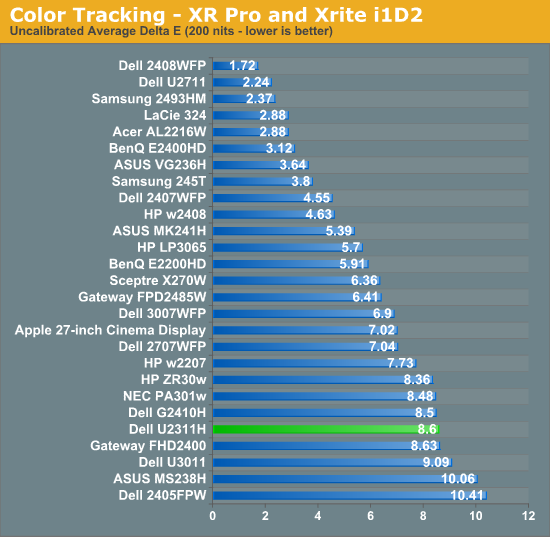
First we looked at the uncalibrated performance with the monitor set to 200 nits and using the include ICM profile from Dell. As you can see, we wind up way off our target dE of 3.0 with an average of 8.6 and a peak value of 14.85. Compared to some other displays this actually isn’t too bad, but it’s nothing you would want to use for serious color work.
For the initial calibration, we used the Custom (RGB) mode on the Dell and calibrated the 100% White Point using the RGB gain controls to be as accurate as possible. We then set calibration targets of 200 nits, D65 for a white point, and a gamma target of 2.2. Once calibrated, we compared the results using the GregTag Macbeth color checker patterns.
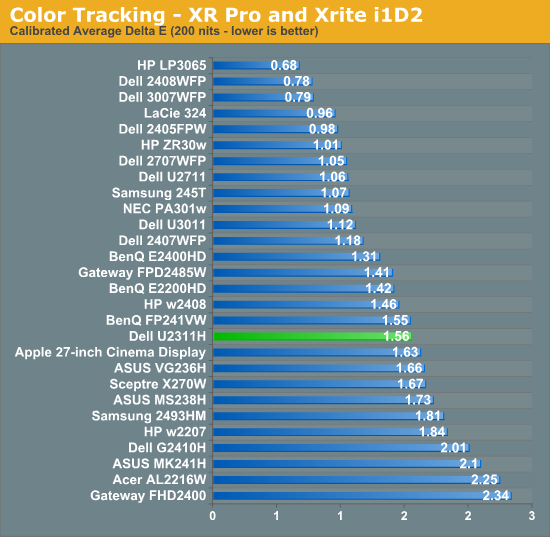
Once we calibrate the Dell, we see our average dE has dropped all the way down to 1.56 and the peak dE is at 5.03. Another thing to keep in mind is that the patches that are generating the highest dE values are ones that are made up mostly of blue. Given your choice, blue is where you want the majority of your dE to occur and green is where you want the least to occur, as the blue light is much lower in light output than red or green, and so errors are not nearly as visible to your eye as they would be in the other colors. Additionally, since the blue light output is much lower, it’s also harder for a colorimeter like the i1D2 to read and therefore more subject to reading errors than green would be. This could account for some of this error and a meter with better dark reading support could resolve that, though most people won’t have one of those for calibrating.
For print work, we then calibrated the monitor using the same specifications, only with a target of 100 nits instead of 200 nits. For a lit room most people would consider this to be too dark of an image, but for print work its much closer to what your actual output would look like.
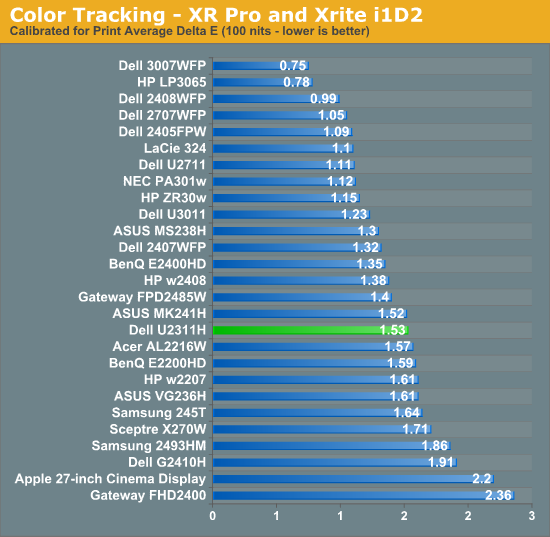
Our average dE here is almost identical at 1.56 but the peak dE is down to 4.75. Again these spikes are occurring in that range that is heavily blue and less noticeable by the human eye. There is a good chance that for the majority of your work you will not have a color error that is visible to the naked eye.


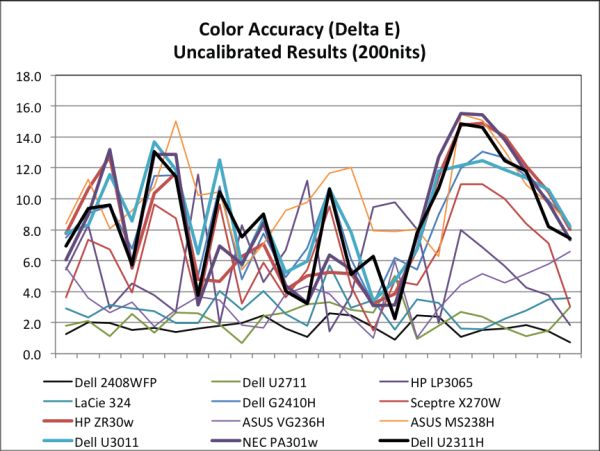
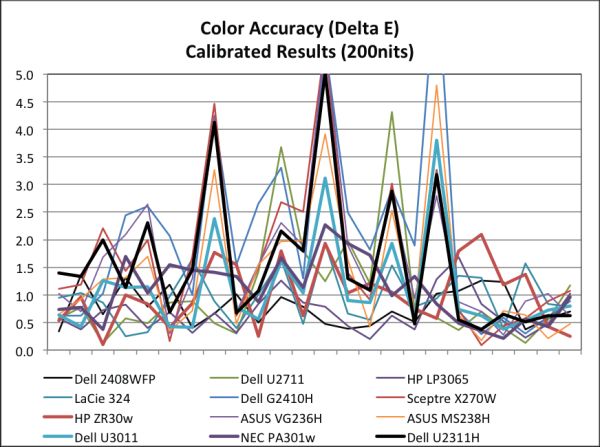
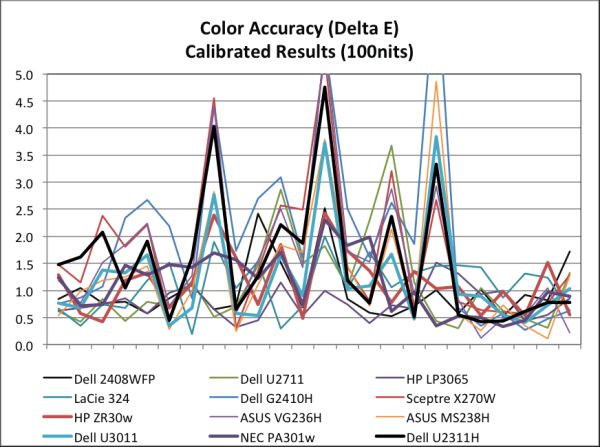








65 Comments
View All Comments
Flunk - Sunday, October 2, 2011 - link
I have one of these, bought it for $220 CDN on sale a month or so ago. I haven't had any problems playing FPSes on it but your mileage may vary.I've been impressed by the build quality and the picture is better than any other monitor I've ever had, if you're not a graphics professional (then you need a 8bit panel) it's definitely a step above.
JoeTF - Tuesday, September 27, 2011 - link
Uhm.Input lag is THE MOST IMPORTANT measurement with e-IPS displays, that are notorious for 30ms+ delays.
Skipping it is like skipping sequential read tests in hdd review.
gevorg - Tuesday, September 27, 2011 - link
This is a previous gen monitor, plenty of reviews on the web. Input lag was measured here:http://www.tftcentral.co.uk/reviews/dell_u2311h.ht...
enterco - Tuesday, September 27, 2011 - link
I own a Dell U2311H, I can't see any noticeable lag. Anyway, the pixperan tool (pixel persistence analyzer) test image looks much better on this display than on my old TN display.ckryan - Tuesday, September 27, 2011 - link
Chris,Are you the new display intern? I too inquired about the highly coveted display internship, but sadly had been beaten to the punch. Ironically, I too am named Chris, and since I had just purchased a new U2311H from Dell, was planning on doing a "review application" of it.
It's a good monitor for the price, but mine has some less than desirable characteristics. However, the input lag is quite low as verified by a couple of other reviews (and my eyeballs), and I only find the off-angle darkening slightly annoying. It calibrates pretty well for me and has excellent black levels for an IPS variant -- that, plus I find CCFL to be generally superior. Just because a display is LED backlit doesn't automatically mean it uses less power -- it's often the case, but identical models that vary solely by backlight use similar amounts of power. Finally, I haven't noticed any artifacts from the 6 bit + AFC implementation, which is a bonus. Overall it's pretty good, but now it's kinda close to the U2412 in price now that it's out, and it looks like a better way to go if you're a fan of 16:10 (and who isn't?).
Anyway, congrats and I'm looking forward to your future reviews.
Daniel Egger - Tuesday, September 27, 2011 - link
> that, plus I find CCFL to be generally superior.CCFL die! Not dead yet? Damn...
The only problem with LED is that companies can't get their stuff together and do it properly and thus we still see crappy LED backlit displays while the high end still tends to use the more known CCFL backlight.
But since NEC recently announced a (what will hopefully turn out to be a nice) LED projector I'm getting my hopes up that we will eventually see a high end LED display from NEC as well. Once that happens HP and Dell will follow suit and we'll have an avalanche of professional grade LED backlit displays coming for us...
Pessimism - Tuesday, September 27, 2011 - link
CCFL needs to die. They may look nicer out of the box but give them a year and they all look weak and yellow. The manufacturers use the cheapest tubes they can find with poor quality phosphors that rapidly loose brightness and color balance. At least LEDs remain consistent for longer, with those you deal with the clear plastic lenses yellowing, again because of poor quality materials.jecs - Tuesday, September 27, 2011 - link
Don't hope CCFL to die too soon or we may get a lot of color precision problems. CCFL may seem old tech but it still produces more neutral color across the spectrum than a white only LED lamp. The downside is more power consumption and heavier units but it is not as important for professionals as it may be for consumers.On the other hand high end LED screens found today on very expensive TVs or monitors uses 3 LED color matrices for each color (RGB). So don't expect anything true LED for desktop use anytime soon.
softdrinkviking - Tuesday, October 4, 2011 - link
jecs +1LEDs still have a long way to go.
they look washed out without being as bright as a CRT. (to me)
alanwong - Tuesday, September 27, 2011 - link
They're selling the U2312HM here in Australia, assume that means the U2311H is out of date?